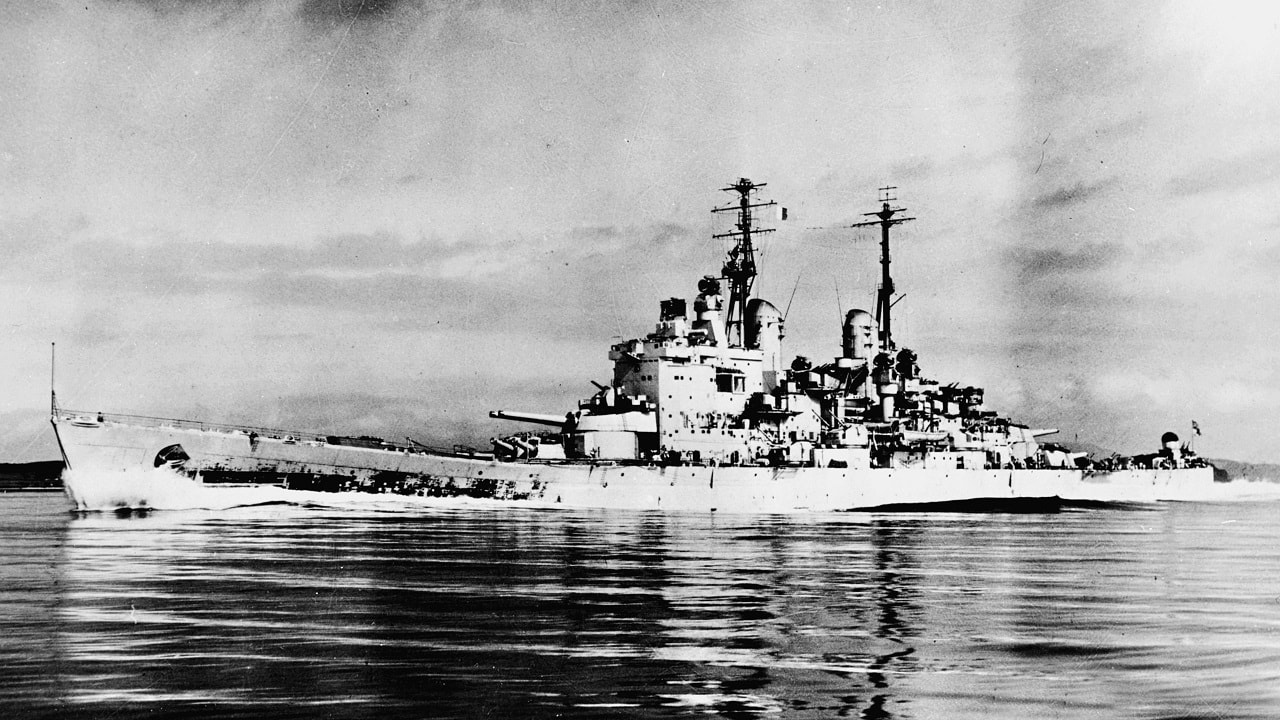HMS Vanguard Was the Last Battleship – There remains some debate on what warship had the distinction of being the “first battleship.” The French oceangoing ironclad Gloire, built in the late 1850s, was classified an armored frigate, yet it certainly could be seen as an early battleship. Other naval historians would argue that Royal Navy’s HMS Monarch, built a decade later with guns mounted in two revolving turrets, should be considered the first battleship.
It is far easier to denote the final battleship to be constructed, and almost fittingly it was another Royal Navy warship, HMS Vanguard – the last of her breed.
Meet HMS Vanguard (23)
Prior to the Second World War, the Royal Navy had been able to maintain its dominance over rival navies both in sheer numbers, but also in having the most advanced warships of the era. It was a tradition that dated back to the HMS Victory, commissioned in 1778, and then with HMS Warrior (1860) and most notably with the development of HMS Dreadnought in 1906.
Yet, by the late 1930s, Britain’s Royal Navy had been surpassed by both the Empire of Japan and Nazi Germany as each had built even more powerful warships. The British reacted accordingly – as they had always done in such situations – and set out to build a larger and even more powerful warship. It was an attempt to make all older ships essentially obsolete, but technology had reached a point where size wasn’t all that mattered.
Development of more powerful battleships began in earnest when the British military believed it would be outnumbered by the combined German and Japanese battleship fleets. The Royal Navy had originally sought to build two Lion-class battleships that were essentially improved and larger versions of the King George V-class.
However, when the war broke out, it became obvious that the two Lion-class warships wouldn’t be ready until 1943 at the earliest. Instead, Sir Stanley Goodall, director of naval construction, offered the suggestion to cut the construction time by producing a single battleship and by using the four twin 15-inch (381mm) turrets removed from battlecruisers HMS Courageous and Glorious – as both sides had been converted to aircraft carriers.
Laid down in 1941 at Clydebank, and still incorporated improvements to the King George V-class including lessons learned from the sinking of the second ship of the class HMS Prince of Wales, HMS Vanguard, which at 44,500 long tons, was the largest Royal Navy warship ever built until the completion of the modern aircraft carrier HMS Queen Elizabeth in 2014.
Key Improvements
Among the notable improvements included replacing the planned 20mm anti-aircraft mounts with 40mm guns – of which HMS Vanguard carried seventy-three. She was also fitted with sixteen 5.25-inch heavy secondary guns for close-in fighting, with those situated as eight double mounts – four on each side of the ship.
The battleship was essentially an improved King George V, with a hull lengthened to accommodate the four center-line turrets and thus a longer main belt, which was reduced by one-inch (25mm) in maximum thickness to save weight. Additional weight was also saved by fitting a transom stern, unique in British battleships – which together with a marked sheer forward made her a steady seaboat even under the most severe conditions. Able to attain a top speed of thirty knots, the battleship was constructed with a beam of 108-feet, which would have allowed her to pass through the Panama Canal.
Wasted Effort?
Construction of the warship actually stopped and restarted during the war, in part as a result of modifications being made to address wartime experience. In fact, HMS Vanguard wasn’t completed until after the war ended, and by the time she entered service she was essentially a relic – time had already passed her by as the age of the massive battleship had come to an end.
Even as she was modernized to World War II standards, it was a controversial decision to employ the smaller 15-inch guns – especially as the ten U.S. Navy modern battleships, as well as the HMS Nelson-class, were outfitted with 16-inch main guns. A concern was that the four sets of the twin Mk I 15-inch guns lacked the range or armor penetration of the more recent and larger weapons.
It was a moot point. She never fired her guns in anger and never was engaged in combat.
However, she remained a symbol of the Royal Navy in the post-World War II era. In 1947, she became a Royal Yacht, and was used by the Royal Family of King George VI on a trip to South Africa. HMS Vanguard was taken out of service in 1955 and became the flagship of the Reserve Fleet a year later.
Movie Set
Among her notable and final accomplishments was serving as the sets for the 1960 film Sink The Bismarck – noteworthy that she was developed in response to the enemy warships. Her interiors were used to depict the bridges, Admiral’s Quarters and notably the gun turrets for HMS Hood and HMS King George V, as well as Bismarck.
There were calls by some in her crew for HMS Vanguard to be saved as a museum ship, the last of her kind. Instead, she met the same ignominious end of too many great warships – she was sold for scrapping in 1960 less than twenty years after she was laid down. It was the end of a short and rather quiet career for Britain’s battleship but for the age of the battleship as well.
Now a Senior Editor for 1945, Peter Suciu is a Michigan-based writer who has contributed to more than four dozen magazines, newspapers and websites. He regularly writes about military hardware, and is the author of several books on military headgear including A Gallery of Military Headdress, which is available on Amazon.com. Peter is also a Contributing Writer for Forbes.

